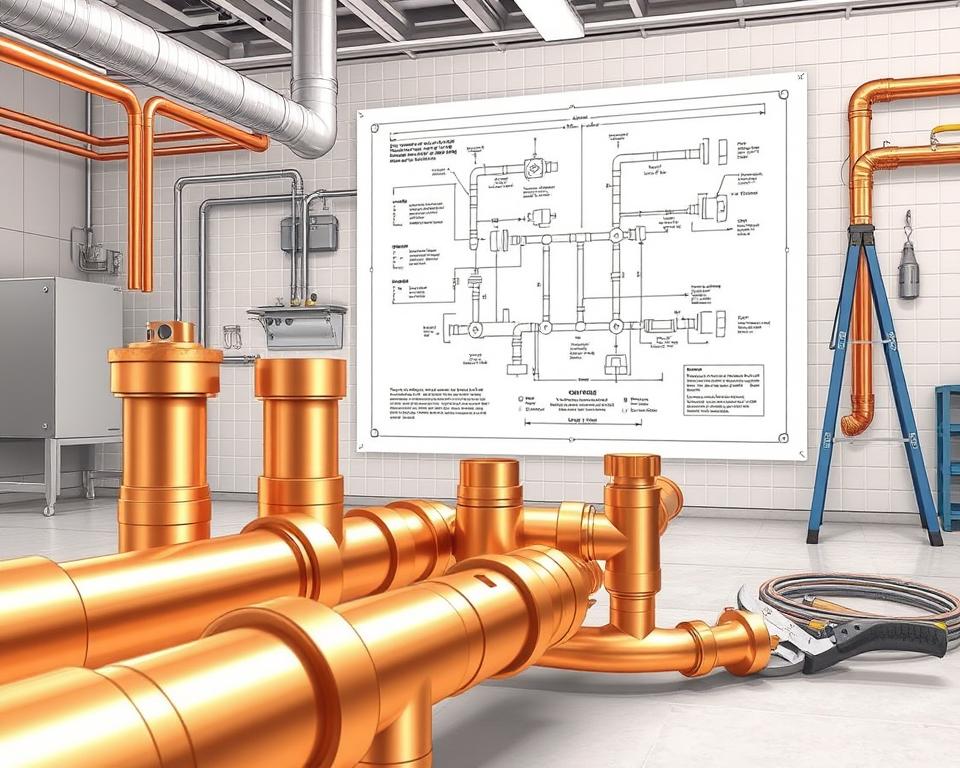Copper Gas Line Installation & Security Guide
Did you know roughly 90% of supply shops offer to cut and form threads on black iron metal piping at a supplementary cost? This piece of data shows the high interest and easy access to gas piping materials, especially copper gas lines. Many homes now favor copper for its durability, dependability, and corrosion resistance. This guide will cover the basics of copper gas lines, their advantages, and essential safety protocols for installation. With insights from Installation Parts Supply, you’ll learn key elements of gas line installation. This understanding guarantees both protection and compliance while satisfying your gas piping requirements.
Summary Points
- Copper gas lines offer robustness and rust resistance.
- Fitting demands proper measurements and compliance with local building codes.
- Protective steps are vital for ensuring leak-free gas lines.
- Understanding the proper routing and placement is crucial for efficient fitting.
- Regular maintenance extends the lifespan of copper gas lines.
Comprehending the Essentials of Copper Gas Lines
Copper gas lines are popular in both residential and business environments. They’re appreciated for safety and dependability. Studying 5 8 copper gas line, covering their merits and contrasting with other substances, is essential. This understanding empowers homeowners to decide wisely.
What is a Copper Gas Line?
A copper gas line uses copper piping for natural gas and propane distribution. It complies with established regulations like the National Fuel Gas Code (NFPA 54/ANSI Z223.1). In regions like Minnesota and Florida, it is preferred for home fuel gas piping. Since 1999, agencies such as IAPMO have approved its use in fuel gas systems.
Advantages of Employing Copper Gas Lines
Copper gas lines offer several notable advantages. They include:
- Corrosion Resistance: Copper surpasses steel and black iron in combating corrosion.
- Flexibility: Its malleability facilitates setup, even in complex layouts.
- Durability: Copper gas lines boast longevity and structural integrity, needing fewer replacements.
- Safety: Complying with strict standards, copper tubing proves reliable in gas distribution.
Contrasting Other Materials
In contrasting copper and steel for gas lines, copper often dominates. Black iron pipes are still common, especially in metropolises such as Chicago. Nonetheless, copper’s lighter weight and simplicity of use have increased its usage. Despite about 50% of gas companies moving to stainless steel due to regulations, copper’s merits persist in certain situations. This is particularly evident in regions such as St. Louis, where modern residences frequently incorporate copper gas lines.
| Required Materials | Tools for Copper Gas Line Fitting |
|---|---|
| Copper pipes (Type K and Type L) | Pipe wrenches |
| Connectors and fittings | Copper cutting tool |
| Plumber’s tape | Soldering kit |
| Protective equipment (gloves, goggles) | Pressure gauge |
Best Practices for Copper Gas Line Installation
Installing copper gas lines comes with specific best practices to ensure safety and efficiency. Key aspects of the process comprise proper layout, firm attachments, and comprehensive leak testing. These measures ensure a gas piping system that is both secure and code-compliant.
Placement and Routing for Copper Gas Lines
Thoughtful planning is crucial when routing copper gas lines. It is imperative to keep these lines separated from architectural components that may cause damage. This strategy averts electrochemical corrosion by preventing contact with dissimilar metals. Also, ensuring easy access for future upkeep and fixes is a must by maintaining clearances.
Adhering to these placement and routing standards improves the system’s safety and longevity.
Joining and Sealing Pipes Properly
Making firm attachments in copper gas pipes necessitates specific materials. Use gas-grade plumber’s tape and gas-specific sealants exclusively. Steer clear of regular thread seal tape to avoid leaks from lubricants on threads. By adhering to proper attachment and sealing methods, risks of gas leaks are significantly reduced, aligning with safety and regulatory requirements.
Leak Testing Post-Installation
Post-installation, performing an exhaustive leak inspection is vital. Begin with a pressure test, applying 1.5 times the system’s maximum working pressure for at least 10 minutes. Alternatively, you may apply soapy water to expose leaks if bubbles form. The desired pressure for these tests should be around 9 inches w.c., with a slight variance allowed. These methods of leak detection are essential for guaranteeing the safety of the gas system, which secures both assets and lives.
Copper Gas Line Safety Regulations
Understanding and following the various rules and guidelines is essential for copper gas line safety. These regulations ensure compliance and reduce risks such as leaks and failures. Both homeowners and contractors need to closely follow local building codes. They must obtain the required permits before initiating any projects.
Grasping Local Building Code Standards
Local building codes set the guidelines for installing copper gas lines. They cover issues like depth of installation, required support systems, and methods for preventing corrosion. For underground pipes, there is usually a requirement for 18 inches of cover. However, in some situations, this can be lowered to 12 inches. Steel sleeves are also often required for copper tubing that goes through wall plates near open edges.
Inspection and Compliance
Regular inspections by licensed inspectors are vital for gas line safety. They ensure that installations comply with both the National Fuel Gas Code and local building codes. These evaluations check whether copper pipes are appropriately fastened and if holes made in joists are the proper dimensions. Meeting these standards enhances safety and ensures reliable operation of gas line installations over time.
Addressing Common Concerns with Copper Gas Lines
Copper gas lines, known for their durability, can experience corrosion problems. It’s crucial to comprehend possible issues and essential maintenance to guarantee safety. Identifying signs of corrosion and the benefits of regular maintenance can stop gas leaks. This information combined with a comparison between copper and steel gas lines helps decide the best material use.
Corrosion Challenges in Copper Gas Lines
Over time, copper gas lines may deteriorate due to external conditions or installation errors. Warning indicators include discoloration, peeling, and unexpected gas bill hikes. Such damage can cause gas leaks, as evidenced by a sulfur odor from added mercaptan. After construction or excavation, checking for visible damage is essential.
Upkeeping Your Copper Gas Line
For security and performance, maintaining copper gas lines is critical. Annual inspections can identify initial signs of corrosion and problems. Keeping appliances clean and well-ventilated prevents gas buildup and carbon monoxide dangers. Only certified professionals should handle repairs or installations, ensuring safety code compliance and reducing failure risks.
Comparing Copper Gas Lines to Steel: Advantages and Disadvantages
Deciding between copper and steel gas lines requires evaluating advantages and disadvantages. Copper’s malleability simplifies setup in tight spaces and typically offers better corrosion resistance. In comparison, steel lines may last longer and cost less for some projects. Understanding these factors aids in choosing the right material for your needs.
To Conclude
The necessity of following best practices for copper gas installation is paramount. Adherence to safety regulations and local codes ensures efficiency and safety. The manual also highlights copper gas lines’ advantages, such as robustness and rust resistance. However, it’s crucial to stay updated on material-related trends.
Maintenance is critical to the longevity and function of copper gas lines. Correct setup and routine evaluations reduce the likelihood of corrosion and system failures. Staying updated on local code revisions is crucial to avoid fines or costly repairs for non-compliance.
Choose expert guidance for copper gas line projects as it is strongly advised. Installation Parts Supply supplies extensive knowledge and support. They ensure your project meets all safety standards, enhancing your system’s security and dependability.
Common Inquiries
How would you define a copper gas line?
A copper gas line is a type of piping for gas distribution. It’s made from copper. This substance is chosen for its durability, malleability, and ability to resist corrosion. These properties make it ideal for home gas installations.
What advantages do copper gas lines offer?
Copper gas lines offer excellent corrosion resistance and flexibility. They are simpler to set up than other substances. Their extended durability and safety features make them perfect for gas distribution systems.
What are the differences between copper gas lines and steel or black iron pipes?
Copper gas lines outperform steel and black iron pipes in several ways. They are more resistant to corrosion and are lighter and easier to handle. Due to these benefits, they are less likely to leak, making them a favored option for many experts.
What steps should be taken prior to installing a copper gas line?
Before installing, you must get local permits and understand gas flow dynamics. Careful planning guarantees a secure, code-adherent setup.
What tools and materials are required for installing copper gas lines?
You’ll need copper pipes, couplings and fixtures, and plumber’s tape. Wrenches for pipes, safety gear, and gas-grade sealants are also critical. These materials ensure firm attachments.
What are the best practices for routing and positioning copper gas lines?
Ensure that they avoid structural elements and dissimilar metals. Adequate support systems are essential to avoid galvanic corrosion.
How do I properly connect and seal copper gas pipes?
Securely connect and seal pipes using gas-grade plumber’s tape and sealants. Always verify your work to prevent leaks.
What methods can be used to detect leaks post-installation of copper gas lines?
Conduct leak tests with a soapy water solution, observing for bubble formation. Pressure testing helps ensure the system’s integrity.
Which safety standards govern the installation of copper gas lines?
Adhere to local building codes, ensure proper installation depth, and secure the necessary permits. Professional inspections are also mandatory.
What are the common corrosion issues associated with copper gas lines?
Corrosion can occur from contact with different metals or external conditions. Prevent this by using proper setup techniques and conducting routine upkeep.
How can I maintain my copper gas line?
Maintain your lines with regular inspections, cleaning, and upkeep. This averts corrosion and leaks, ensuring a long lifespan.
When should I choose copper gas lines over steel?
Choose copper for home applications due to its malleability and low corrosion risk. Steel is better suited for high-pressure, industrial settings.



